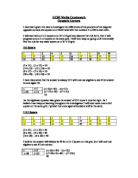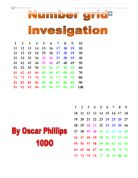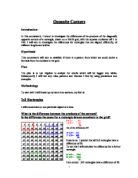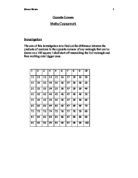For my investigation I will be finding out patterns and differences in a number grid.
Introduction For my investigation I will be finding out patterns and differences in a number grid. An example of a number grid that I am going to use for my investigation is shown below. Columns 2 3 4 5 6 7 8 9 0 1 2 3 4 5 6 7 8 9 20 21 22 23 24 25 26 27 28 29 30 31 32 33 34 35 36 37 28 39 40 41 42 43 44 45 46 47 48 49 50 51 52 53 54 55 56 57 58 59 60 61 62 63 64 65 66 67 68 69 70 71 72 73 74 75 76 77 78 79 80 81 82 83 84 85 86 87 88 89 90 91 92 93 94 95 96 97 98 99 00 Rows As you can see I will draw a box on the number grid and multiply the top left number with the bottom right number in the box. I will then do the same for the top right and the bottom left number. Once I have the sum for each multiplication I will then find the difference between the two calculations. I will different size of boxes e.g. 2x2 and 3x3; these numbers represent the number of numbers there are across the side of box and on top of the box. An example of this would be 4x4 means there is 4 numbers on the side and 4 numbers on the top as shown below. 2 3 4 1 2 3 4 21 22 23 24 31 32 33 34 Multiply the top left number with the bottom right number then do the same, multiply the bottom left number with the top right number. After this take both calculations and minus them both from
Algebra Investigation - Grid Square and Cube Relationships
Algebraic Investigation 1: Square Boxes on a 10x10 Grid In this first investigation, the difference in products of the alternate corners of a square, equal-sided box on a 10x10 gridsquare will be investigated. It is believed that the products and their differences should demonstrate a constant pattern no matter what dimensions are used; as long as they remain equal. In order to prove this, both a numeric and algebraic method will be used in order to calculate this difference. The numeric method will help establish a baseline set of numbers for testing, and to help in the establishment of a set of algebraic formulae for use on an n x n gridsquare. In the example gridsquare below, the following method is used in order to calculate the difference between the products of opposite corners. (a) (b) (c) (d) Stage A: Top left number x Bottom right number = (a) multiplied by (d) Stage B: Bottom left number x Top right number = (c) multiplied by (b) Stage B - Stage A: (c)(b) - (a)(d) = The difference The overall, 10 x 10 grid that is used for the first investigation will be a standard, cardinal gridsquare, which progresses in increments of 1. The formulae calculated will mainly be applicable to this grid, as other formats of gridsquares will require others formulae to provide valid results. 2 3 4 5 6 7 8 9 0 1 2 3 4 5 6 7 8 9 20 21 22 23 24 25
Mathematical Coursework: 3-step stairs
91 92 93 94 95 96 97 98 99 00 81 82 83 84 85 86 87 88 89 90 71 72 73 74 75 76 77 78 79 80 61 62 63 64 65 66 67 68 69 70 51 52 53 54 55 56 57 58 59 60 41 42 43 44 45 46 47 48 49 50 31 32 33 34 35 36 37 38 39 40 21 22 23 24 25 26 27 28 29 30 1 2 3 4 5 6 7 8 9 20 2 3 4 5 6 7 8 9 0 In order to understand the relationship between the stairs total and the position of the stairs shape on the grid. Foremost, I needed to distinguish if the stair total had something in common. As I believe this would enable me to find a pattern, which would eventually develop into an algebraic equation. To be able to do this I had to experiment with the grid, by shifting the 3-step stairs into different direction et cetera. In addition I would've seen if the pattern and algebraic equation would've work in different size grid such as 9cm by 9cm or in different size stair shape such as 4- step stairs. In order to find the pattern I will have to draw various grids, this will enable me to eventually discover the pattern. Firstly, for my first experimental grid I decide the start in the bottom corner and randomly select a few other 3-step stairs. 91 92 93 94 95 96 97 98 99 90 81 82 83 84 85 86 87 88 89 80 71 72 73 74 75 76 77 78 79 70 61 62 63 64 65 66 67 68 69 60 51
Investigation of diagonal difference.
Maths coursework Investigating diagonal difference Aim: For this course work my task is to investigate the diagonal difference of different size cutouts on different size grids. 2 3 4 5 6 7 8 9 0 1 2 3 4 5 6 7 8 9 20 21 22 23 24 25 26 27 28 29 30 31 32 33 34 35 36 37 38 39 40 41 42 43 44 45 46 47 48 49 50 51 52 53 54 55 56 57 58 59 60 61 62 63 64 65 66 67 68 69 70 71 72 73 74 75 76 77 78 79 80 81 82 83 84 85 86 87 88 89 90 91 92 93 94 95 96 97 98 99 00 E.g. this is a 2x2 cutout on a 10x10 grid. Finding the diagonal difference of a cutout is achieved by finding the product of the bottom left corner and the top right corner, then the product of the bottom right corner and the top left corner and finally calculating the difference between these two products. 2 1 2 I will investigate the diagonal differences for cutouts anywhere on a grid and use algebra to prove any rules I may discover. I will log my results in a table to help me to find any formulas that may become apparent as I proceed. As I investigate this problem I will make appropriate predictions from rules I may discover from the table of results I produce, and from any patterns that can be seen. Method: I will start by investigating the diagonal difference of 2x2 cutouts on 10x10 grids. 2x2 cutouts What is
number grid
Algebraic Investigation 1: Square Boxes on a 10x10 Grid In this first investigation, the difference in products of the alternate corners of a square, equal-sided box on a 10x10 gridsquare will be investigated. It is believed that the products and their differences should demonstrate a constant pattern no matter what dimensions are used; as long as they remain equal. In order to prove this, both a numeric and algebraic method will be used in order to calculate this difference. The numeric method will help establish a baseline set of numbers for testing, and to help in the establishment of a set of algebraic formulae for use on an n x n gridsquare. In the example gridsquare below, the following method is used in order to calculate the difference between the products of opposite corners. (a) (b) (c) (d) Stage A: Top left number x Bottom right number = (a) multiplied by (d) Stage B: Bottom left number x Top right number = (c) multiplied by (b) Stage B - Stage A: (c)(b) - (a)(d) = The difference The overall, 10 x 10 grid that is used for the first investigation will be a standard, cardinal gridsquare, which progresses in increments of 1. The formulae calculated will mainly be applicable to this grid, as other formats of gridsquares will require others formulae to provide valid results. 2 3 4 5 6 7 8 9 0 1 2 3 4 5 6 7 8 9 20 21 22 23 24 25 26
number grid investigation]
Algebraic Investigation 1: Square Boxes on a 10x10 Grid In this first investigation, the difference in products of the alternate corners of a square, equal-sided box on a 10x10 gridsquare will be investigated. It is believed that the products and their differences should demonstrate a constant pattern no matter what dimensions are used; as long as they remain equal. In order to prove this, both a numeric and algebraic method will be used in order to calculate this difference. The numeric method will help establish a baseline set of numbers for testing, and to help in the establishment of a set of algebraic formulae for use on an n x n gridsquare. In the example gridsquare below, the following method is used in order to calculate the difference between the products of opposite corners. (a) (b) (c) (d) Stage A: Top left number x Bottom right number = (a) multiplied by (d) Stage B: Bottom left number x Top right number = (c) multiplied by (b) Stage B - Stage A: (c)(b) - (a)(d) = The difference The overall, 10 x 10 grid that is used for the first investigation will be a standard, cardinal gridsquare, which progresses in increments of 1. The formulae calculated will mainly be applicable to this grid, as other formats of gridsquares will require others formulae to provide valid results. 2 3 4 5 6 7 8 9 0 1 2 3 4 5 6 7 8 9 20 21 22 23 24 25 26
I am doing an investigation to look at borders made up after a square gets bigger.
Introduction I am doing an investigation to look at borders made up after a square gets bigger. In this investigation I will be drawing and analyzing patterns and sequences called Borders. I will start off with the border 1 by 2 or it can be also called 2 by 1. This means that I will be drawing 2 squares side by side and will be surrounding each side by squares until I come to the fifth border. This is an efficient amount of borders to work out the sequence formula after this I will have valid information to predict a sixth border. I will draw up the sixth border to see if I am right. I will be doing this until 5x6 where I will stop to find out the general rules. Starting with 1 by 1, then: by 2 by 3 by 4 by 5 2 by 2 2 by 3 2 by 4 2 by 5 3 by 3 3 by 4 3 by 5 4 by 4 4 by 5 5 by 5 5 by 6 I will try to find the formula for y by 1, Y by 2 Y by 3 Y by 4 Y by 5 Also I will find out X by Y. From this I will try to find out how big the border is. Investigating Borders BY 1 5 5 4 5 5 4 3 4 5 5 4 3 2 3 4 5 5 4 3 2 2 3 4 5 5 4 3 2 2 3 4 5 5 4 3 2 2 3 4 5 5 4 3 2 3 4 5 5 4 3 4 5 5 4 5 5 Border Number=B Number of numbered squares=N 4 2 8 3 2 4 6 5 20 Using my table of results I can work out a rule finding the term-to-term rule. With the term-to-term rule I can predict the 6th border. As you
Number Grid Investigation
Number Grid Investigation 2 3 4 5 6 7 8 9 0 1 2 3 4 5 6 7 8 9 20 21 22 23 24 25 26 27 28 29 30 31 32 33 34 35 36 37 38 39 40 41 42 43 44 45 46 47 48 49 50 51 52 53 54 55 56 57 58 59 60 61 62 63 64 65 66 67 68 69 70 71 72 73 74 75 76 77 78 79 80 81 82 83 84 85 86 87 88 89 90 91 92 93 94 95 96 97 98 99 00 This is a simple 10 x 10 number grid. I am now going to investigate 2x2 squares on this 10x10 number grid. A B C D A, B, C and D all represent numbers in a 2x2 square, I am going to multiple the 2 diagonal numbers together and find the difference of their products. I will pick a 2x2 number square at random and investigate it: 23 24 23x34= 782 Difference = 10 33 34 24x33= 792 The difference between the two products is 10 I will now choose another 2x 2 Square to see if this pattern follows. 47 48 47x58= 2726 Difference = 10 57 58 57x48= 2736 The difference in both these 2x2 squares is 10 a pattern seems to be emerging, I will now try another 2x2 square to convince me this pattern works throughout the number grid. 86 87 86x97= 8342 Difference = 10 96 97 87x96= 8352 I am now convinced that the difference between the two diagonal products in a 2x2 number square is 10. I will
number grid
Number Grid For this task I will first be looking at a number grid from 1 to 100, like the one below: 2 3 4 5 6 7 8 9 0 1 2 3 4 5 6 7 8 9 20 21 22 23 24 25 26 27 28 29 30 31 32 33 34 35 36 37 38 39 40 41 42 43 44 45 46 47 48 49 50 51 52 53 54 55 56 57 58 59 60 61 62 63 64 65 66 67 68 69 70 71 72 73 74 75 76 77 78 79 80 81 82 83 84 85 86 87 88 89 90 91 92 93 94 95 96 97 98 99 00 I will start my investigation by looking at 2 by 2 squares. I will draw a square around 4 numbers, find the product of the top left and bottom right numbers and the product of the bottom left and top right numbers, then calculate the difference the between the 2 products. I will see if there are any patterns and if so I will try to work them out algebraically. I will then look at changing the size of the squares to see if there are any patterns. I will try looking at 3 by 3 squares, 4 by 4 squares and 5 by 5 squares; I will do the same with these squares as I have with the 2 by 2 squares, I will find the products of the top left and bottom right and the bottom left and top right numbers then calculate the difference between them. Once I have fully investigated the patterns within the squares and found an algebraic formula for the patterns I will look at rectangles. I will start by looking at a 2 by 3
For other 3-step stairs, investigate the relationship between the stair total and the position of the stair shape on the grid. To start the investigation a 10x10-numbered grid square is used as illustrated below in table 1:
Mill Hill County High School Year 11 Mathematics GCSE Coursework EDEXCEL 2003, SYLLABUS 1387/1388 F, I & H Tejesh Patel Class 11H Assignment Part 1 Below is a 10x10 number grid: The total on the numbers coloured in blue = 90 (i.e. 1+11+12+21+22+23) Therefore the stair total in this 3-step stair = 90 Part 1 Objective: For other 3-step stairs, investigate the relationship between the stair total and the position of the stair shape on the grid. To start the investigation a 10x10-numbered grid square is used as illustrated below in table 1: From the complete 10 x 10 numbered grid square, we use part of it to carry out our initial investigation, for example the grid box on the right shows a slice of the 10 x 10 gird square, i.e. 6 boxes representing the numbers 1,11,12,21,22,23 (The 3-step stair) From this basic numbered square that looks like stairs or steps we can start to establish if there is a pattern. If a pattern is found then we can use an algebra equation to represent this pattern and use the equation for a 10 x 10 numbered Grid Square. By using the 3-step stair example we know there are [6] squares and lets assume in a 3-step stair the bottom grid box is equal to [x], therefore in our 3-step stair x = 21 Using the values in algebra the formula(s) would look like this: The 1st square = 1 then the formula is x - 20 = 1 The 2nd square = 11 then the formula



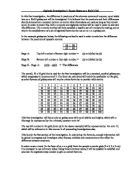



![number grid investigation]](https://mbt-essays-prod-public.s3.eu-west-1.amazonaws.com/810836/listing/810836_1.jpg)




